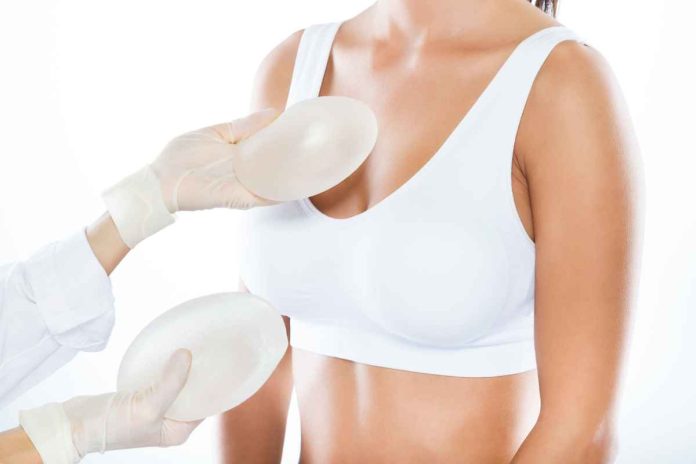From using injections of glycerine, ox cartilage, and autologous fat to modern advancements, breast implants have come a long way.
But it’s not just about the physical transformation; breast implants have sparked discussions about body image, self-esteem, and societal norms, challenging us to examine our perceptions of beauty and individuality.
Therefore, it’s essential to understand the different breast implant types and work with a skilled surgeon to get the best results.
Types of Breast Implants
One of the critical factors in achieving a successful breast augmentation outcome is selecting the right breast implant type.
Saline Implants
Saline implants are filled with a sterile saltwater solution. They are filled after they are placed in the breast pocket, offering flexibility in achieving desired volume and symmetry. In the event of a rupture, saline is harmlessly absorbed by the body.
Silicone Gel Implants
Silicone gel implants consist of a silicone shell filled with a cohesive silicone gel. They provide a natural look and feel, closely resembling the texture of natural breast tissue.
In case of rupture, the gel typically stays within the implant shell or remains confined to the implant pocket.
Structured Saline Implants
These implants are filled with saline but contain an internal structure to provide additional support. The structured design helps to maintain the shape of the implant, reducing the risk of rippling or collapse.
Gummy Bear Implants
Also known as highly cohesive gel implants, gummy bear implants are filled with a form-stable silicone gel.
The gel retains its shape even if the implant shell is damaged, resulting in a teardrop or anatomically shaped appearance.
Breast Implant Shapes
Breast implants come in two primary shapes: round and anatomical (teardrop).
Round Implants
- Symmetrical shape that provides a fuller appearance
- Less likely to rotate and cause visible distortion
- Can be used with various projection profiles
Anatomical (Teardrop) Implants
- Mimics the natural breast shape with a fuller lower portion
- Ideal for patients seeking a subtle, natural enhancement
- Requires precise surgical placement to prevent rotation
Factors to Consider When Choosing Breast Implant Types
Several factors should be considered when selecting the right breast implant type for your unique goals:
- Body type: Your body’s frame and existing breast tissue are significant in determining the best implant type. A skilled surgeon will assess your anatomy and recommend the most suitable implant material, shape, and size.
- Natural breast size: If you have smaller breasts, you may opt for implants that provide a more noticeable enhancement, while those with larger natural breasts might choose implants that offer a more subtle augmentation.
- Desired appearance: Consider whether you prefer a more natural or fuller look, as this will influence the choice of implant material and shape.
- Lifestyle: Your activity level and hobbies may impact your decision, as certain implant types may be more suitable for those with active lifestyles or specific aesthetic goals.
- Maintenance: Be prepared to commit to regular monitoring and potential future surgeries, as implants may need to be replaced or adjusted over time.
Frequently Asked Questions
How Long Is the Recovery Period After Breast Augmentation Surgery?
Generally, patients can expect to resume normal activities within a week or two, but it may take several weeks to fully recover and for the swelling to reduce.
Are Breast Implants Safe?
Breast implants approved by regulatory authorities, such as the FDA, have undergone extensive testing for safety and efficacy. However, any surgical procedure may have certain risks, so you should choose a qualified plastic surgeon to minimize potential complications.
Can I Breastfeed With Breast Implants?
Many women can successfully breastfeed with breast implants, but the ability to do so depends on various factors, including the surgical technique used and individual anatomy. Make sure to discuss your breastfeeding goals with your surgeon during the consultation.
How Often Should Breast Implants Be Replaced?
Most FDA-approved implants can last for 10 to 20 years, but you should schedule follow-ups with your surgeon to make sure they are in good condition.
Can Breast Implants Increase the Risk of Breast Cancer?
Breast implants do not increase the risk of breast cancer. However, they may affect the detection of breast cancer during mammography. Inform the radiologist about your implants for appropriate imaging techniques to be used.
How Do I Choose the Right Surgeon for My Breast Augmentation?
Selecting a skilled, board-certified plastic surgeon with experience in breast augmentation is crucial to achieving the best results.
Look for a surgeon with an extensive portfolio of before-and-after photos, positive patient testimonials, and a thorough understanding of the various breast implant types.
How Much Does Breast Augmentation Surgery Cost?
The cost of breast augmentation varies depending on factors such as the surgeon’s experience, geographic location, and the chosen implant type. However, the average cost is $4,516. Consult a board-certified plastic surgeon for a personalized quote.


